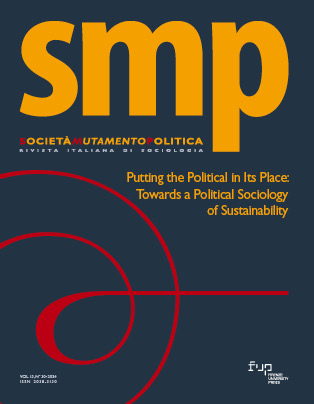Published 2024-12-30
Keywords
- Emotions,
- Aesthetics,
- Animal Suffering,
- Social Movements,
- Veganism
How to Cite
Copyright (c) 2024 Giacomo Lampredi

This work is licensed under a Creative Commons Attribution 4.0 International License.
Abstract
This article discusses some results emerging from qualitative social research about anti-speciesist aesthetic activism in Turin and Verona (Italy). Such activism aims to provoke moral-affective ruptures through the visibility of animal suffering. The social movements under examination are involved in call-to-responsibility action, through affective rupture. Some affective manifestations can be performed, under certain circumstances, as real acts of disruption. These acts aim to break consolidated and habitual ways of creating morality. This work will describe the so-called “funeral rituals” of these social movements and how these are employed to communicate the social and structural causes of the systemic killing of animals. Being a vegan activist often means being a source of disturbance, annoyance and discomfort for others, but also of curiosity and wonder. The research was carried out by using multiple ethnographic and qualitative methods to provide a deep analysis of the processual and relational aspects of this form of aesthetic activism.
References
- Anderson B. (2009), «Affective atmospheres», in Emotion, space and society 2(2): 77-81, https://doi.org/10.1016/j.emospa.2009.08.005
- Ayata B. (2019), «Affective citizenship», in J. Slaby and C. Von Scheve (eds.), Affective societies, Routledge, London, 330-339.
- Bakhtin M. (1984), Rabelais and His World, trans, Indiana University Press, Bloomington.
- Bateson G. (2000), Steps to an ecology of mind: Collected essays in anthropology, psychiatry, evolution, and epistemology, University of Chicago Press, Chicago.
- Bertuzzi N. (2018), I movimenti animalisti in Italia. Politiche, strategie e pratiche di attivismo, Meltemi, Milano.
- Brighenti A. M. (2010), Visibility in Social Theory and Social Research, Palgrave Macmillan, London.
- Burkitt I. (2012), «Emotional reflexivity: Feeling, emotion and imagination in Reflexive Dialogues», in Sociology, 46 (3): 458-472, https://doi.org/10.1177/0038038511422587
- Butler J. (2015), Notes toward a performative theory of assembly, Harvard university Press, Cambridge.
- Candiotto L. and Dreon R. (2021), «Affective scaffoldings as habits: A pragmatist approach», in Frontiers in Psychology, 12, https://doi.org/10.3389/fpsyg.2021.629046
- Collins R. (2004), Interaction ritual chains, Princeton University Press, Princeton.
- Cooley C. H. (2017), Human nature and the social order, Routledge, New York.
- de La Bellacasa M. P. (2017), Matters of care: Speculative ethics in more than human worlds, University of Minnesota Press, Minneapolis.
- Dewey J. (1894), «The Theory of Emotions. 1. Emotional Attitudes», in The Psychological Review, 1(6): 553-569.
- Dewey J. (1895), «The Theory of Emotions. 2. The significance of emotions», in Psychological Review, 2(1): 13-32.
- Dewey J. (1980), Art as Experience, Wideview/Perigree, New York.
- Donaldson S. and Kymlicka W. (2011), Zoopolis: A political theory of animal rights, Oxford University Press, Oxford.
- Donovan J. and Adams C.J. (eds.) (2007), The feminist care tradition in animal ethics: A reader, Columbia University Press, New York.
- Duncombe S. (2007), Dream: Reimagining Progressive Politics in an Age of Fantasy, The New Press, London.
- Durkheim E. (2001), The Elementary Forms of Religious Life, Oxford University Press, Oxford.
- Elias N. and Dunning E. (1986), Quest for excitement. Sport and leisure in the civilizing process, Basil Blackwell, Oxford.
- Fernández L. (2021), «Images that liberate: Moral shock and strategic visual communication in animal liberation activism» in Journal of Communication Inquiry, 45(2): 138-158, https://doi.org/https://doi.org/10.1177/0196859920932881
- Franklin A. (1999), Animals and modern cultures: A sociology of human-animal relations in modernity, Sage, London.
- Garfinkel H. (1967), Studies in Ethnomethodology, Prentice-Hall, Englewood Cliffs.
- Hall R. T. (2018), «Animal Rights: A Sociological Approach» in dA Derecho Animal: Forum of Animal Law Studies, 9(4), 29-35. https://doi.org/10.5565/rev/da.353
- Hochschild A.R. (1983), The managed heart: The commercialization of human feelings, University of California Press, Berkeley.
- Holmes M. (2010), «The emotionalization of reflexivity», in Sociology, 44(1): 139-154, https://doi.org/10.1177/0038038509351616
- Ingold T. (2016), What is an animal? Routledge, London and New York.
- Isin E.F. (2008), «Theorizing acts of citizenship» in E. F. Isin and G. M. Nielsen (Eds.), Acts of citizenship, Bloomsbury Publishing, London, 15-43.
- Isin E.F. (2009), «Citizenship in flux: The figure of the activist citizen», in Subjectivity, 29(1): 367-388, https://doi.org/10.1057/sub.2009.25
- Jasper J.M. (2008), The art of moral protest: Culture, biography, and creativity in social movements, University of Chicago Press, Chicago.
- Kershaw B. (1997), «Fighting in the Streets: Dramaturgies of Popular Protest, 1986–1989», in New Theatre Quarterly, 13.51: 255–76
- Mead G.H. (2001), «The social character of the instinct», In M. J. Deegan (Ed), Essays in Social Psychology, Transaction Publisher, New Brunswick-London, 3-8.
- Milohnić A. (2005), «Artivism», in Maska, 20 (1–2): 15–25.
- Peggs K. (2012), Animals and Sociology, Palgrave Macmillan, Houndmills.
- Rancière J. (1999), Disagreement: Politics and philosophy, University of Minnesota Press, Minneapolis.
- Schechner R. (1999), The Future of Ritual: Writings on Culture and Performance, Routledge, London and New York.
- Tavory I. and Timmermans S. (2014), Abductive analysis: Theorizing qualitative research, University of Chicago Press, Chicago.
- Taylor N. and Twine R. (2015), Rise of Critical Animal Studies, Routledge, New York.
- Wrenn C. (2012), «Applying social movement theory to nonhuman rights mobilization and the importance of faction hierarchies», in The Peace Studies Journal, 5(3), 27-44.
- Jones S.T., Adams E. and Ellis C. (2016), Handbook of autoethnography, Routledge, London.

